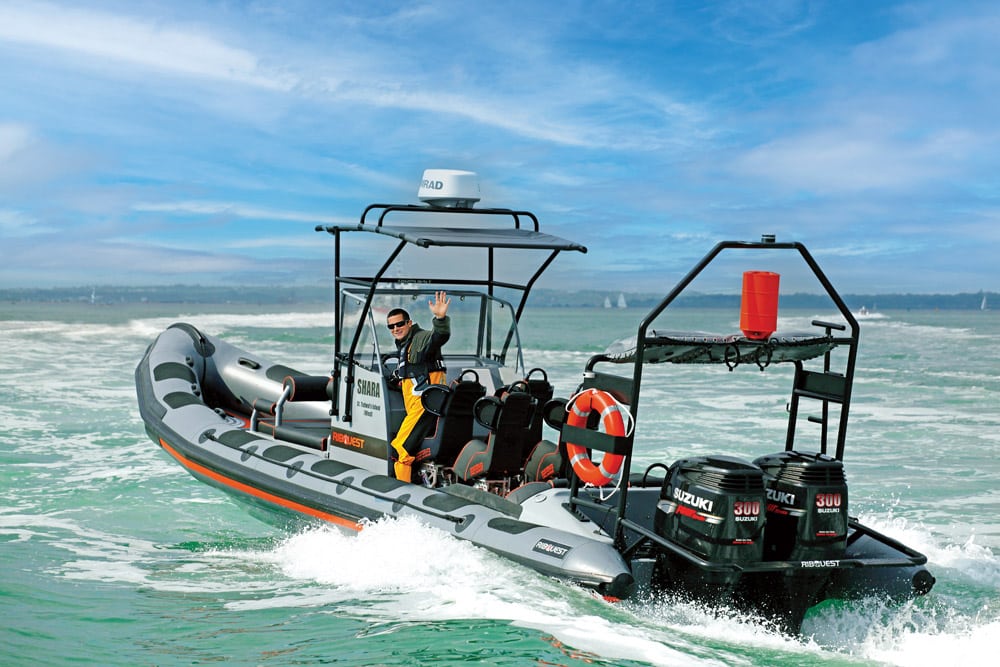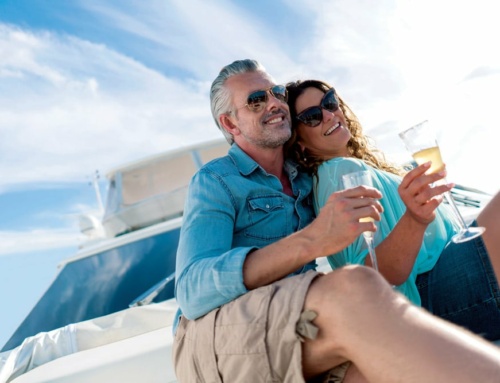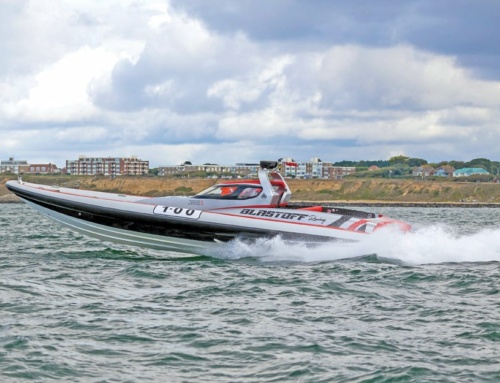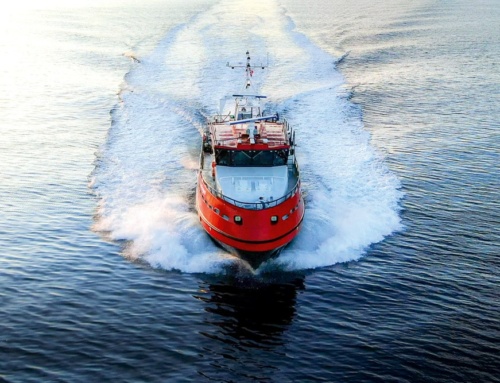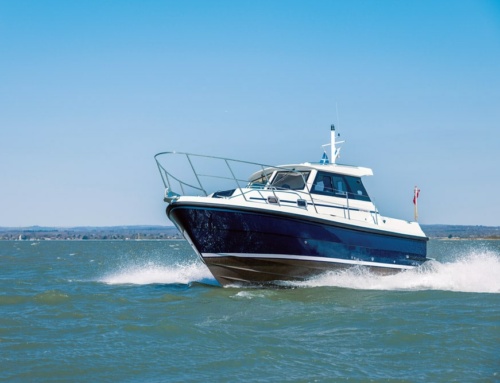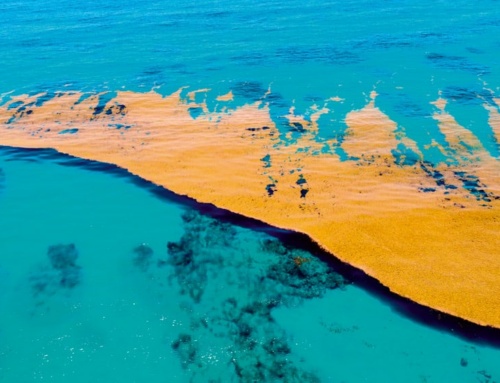In the first of our brand-new series ‘Ask the Expert’, world-renowned adventurer, explorer and former SAS reservist Bear Grylls reveals to HMS the principles of survival and why his love of small boats remains undaunted.
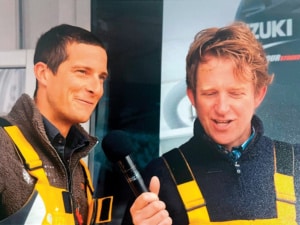
Bear talking to HMS.
It’s great to hook up with you again, Bear, and thanks so much for agreeing to give us the benefit of your acquired knowledge. Many will know of your famous land-based exploits, but the sea is likewise a passion of yours too, is it not?
Yes, it always has been. Boating and the sea lie at the heart of what I do professionally, but also privately too. I was brought up on the Isle of Wight where boating was part of everyday life. But where my family and I currently live, on our small island off the North Wales coast, it’s the same. So the sea is rooted in my family’s life, and I like that.
Before we get into all that, though, I’d love to say what a great job you are doing with the magazine, for all the inspiration, education and aspiration it delivers. We all need those things. And you also encourage folk to get out there themselves, creating their own cool trips and amazing adventures. So well done.
Thanks, Bear, that’s good to hear. We try to share genuine, practical knowledge with our readers. This is thanks to a writing team that comes to a subject armed with first-hand knowledge and a passion for what they’re writing.
Yep, that’s key – knowledge based on experience. I reckon the most valuable knowledge I’ve accrued in life, whether at sea or in the mountains, has been learned through practical experience. It’s a fact that some of the best mariners I know are those whose chief resource is that ‘bag of experience’ – one they’re constantly filling and adding to through actually being ‘out there’, applying what they know in the real environment.
Boating, as in the case of mountaineering, can confront you with a situation where you just get one chance. The odds may not allow you to make the same mistake twice and still escape with your life. Out at sea, as on the mountain face, I’ve learnt that it’s better to leave your ego at home and be sure to trust your common sense and good judgement instead.
Interestingly, there’s a shift in the ‘health and safety’ world increasingly towards acknowledging ‘experience’ rather than forms and certificates alone. This, I think, is a really positive development and helps to bring sense and practical judgment to the table. The maritime world especially can suffer at times from being fixated with dockets and certificates.
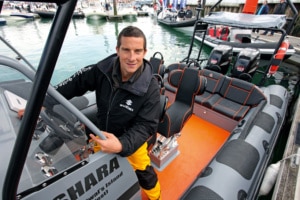
Bear at RIBEX, Cowes
Can I ask you your views on the subject of ‘escalation’ – how to prevent a relatively minor incident becoming a serious, life-threatening situation?
Good question. I think the principle here is that maritime disasters are rarely caused by just one big incident. They tend to be the result of perhaps three or four apparently inconsequential incidents converging and then ultimately conspiring against you. In other words, maybe you’ve let an unsecured line work its way out of an elephant trunk scupper, so it snags the propellor. When you move to the back of the craft to attend to the issue, you forget to disconnect the kill cord, so under strain, it gets pinged straight out over the side of the boat into the sea. You then realise you don’t have a spare cord, so now you can’t even restart the engine even if you do manage to get the rope cut. Worst of all, you’re now drifting onto a lee shore. So leaving the issue of the snagged rope aside, you hasten up into the bow to the anchor locker, only to find the anchor warp is a 50-metre tangled mess of knotted rope … These are all relatively small things that put together can fast create a disaster. You get the idea?
That’s why my advice is ‘never get complacent’, because complacency kills. Try to avoid getting distracted by mobile phones or even unnecessary use of instrumentation. Stay focused. Remember that if you are at sea, you’re the master of a powerful craft that has the power to kill. Treat the boat and the environment with respect and take note of local regulations too. The latter are there to safeguard you and others as well.
As a professional adventurer and explorer, what importance do you place on having a ‘plan B’?
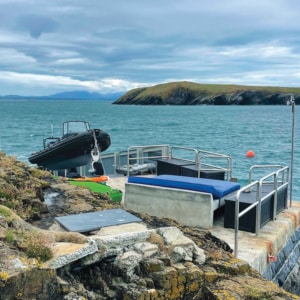
Sealegs ready for any serious adventure.
Whether on land or at sea, my advice is: always have a backup plan. Hope for the best but prepare for the worst. If you’re setting out on a passage, make sure somebody knows where you’re going and when you’ll be back. Then, if something does go wrong, you can have the assurance that someone is going to be looking for you. Related to this, I would advise not overestimating your ambition, and certainly don’t underestimate the power of the wind, the tide and the waves. While we all feel the need to push things at times, there is a danger in underestimating the conditions and the logistical challenges involved when undertaking long-distance offshore challenges in particular.
As in the case of paragliding, there’s only one thing worse than being on the ground and wanting to be in the air – that’s being in the air and wanting to be on the ground! It’s the same with boating.
It’s good to remember that the sea will always be there, and things invariably go wrong when you try and force your aims when the circumstances are not right. The truth is, in the main, that when the seas are strong and the weather’s foul, nobody really has fun, so wait for a better moment.
You’ve had some pretty close calls over the years. What lessons have you derived from these?
Firstly, I’m very grateful to have lived to tell the tale and survived a whole bunch of narrow escapes over the years – not all of which, I confess, I am proud of! But often, those near-death escapes have come about as a result of pushing when maybe I should have listened and slowed down more. This definitely happened on our Arctic RIB crossing, when on a couple of occasions we were up against it in terms of time, with the pressure of the season’s change and ice threatening to return. The forecast weather window wasn’t quite long enough, and I knew it, but I chose to go for it all the same. In truth, we got lucky to have survived at all on several occasions! It was a typical example of two negative forces uniting against us: time pressures and a dwindling forecast.
The lesson I learnt was most certainly that discretion is sometimes the better part of valour when it comes to the sea and the forces of nature. You will only get it wrong once. My great-grandfather died when his ship sank during a storm. I’ve never forgotten that.
Can I draw you on the matter of kit – where do you stand with this?
If the kit has a direct bearing on your safety or that of your crew, it’s important to get the best you can afford. Life jackets are an obvious example, but of course, the importance of life jackets goes far beyond simply wearing one. You need to consider what condition it’s in. Has the item been serviced and when was the last time you checked the auto-inflate system within the sleeve of the garment? Has this got corroded over time? If you’re in a cabin craft, are you wearing the correct manual inflation type or are you wearing an auto-inflation jacket that could pin you fast against a bulkhead if the boat inverted or was flooded?
Likewise, with manual kill cords, wearing one is one thing, but wearing the kill cord lanyard correctly is quite another. If it’s around your wrist, it can easily slip off if you’re ejected. The same can occur if the cord is wrapped below your knee. Avoid attaching the lanyard to your clothing or your life jacket as it can snag on the wheel.
Also, in terms of good comms and safety, most offshore passages, by their nature, are out of cell reception. So it’s even more critical that your vessel has a working VHF radio. Nowadays there are quite strict licensing regulations over their use, but personally speaking, I would much prefer that someone without a VHF licence knew the basics and was able to exercise that knowledge in a situation where they felt they needed to, rather than holding back because of being fearful that they may be breaking the ‘law’. If someone determines that they genuinely need to dial up Channel 16 and transmit, then they should do it.
Tell us about an experience at sea that taught you a lifelong lesson.
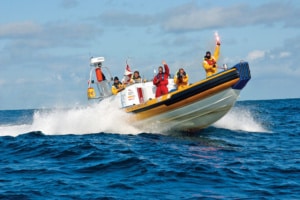
Bear’s first Cross-Atlantic craft. An aluminium hulled Ocean Dynamics RIB.
I remember setting off on a 90-mile passage across Cardigan Bay with a buddy of mine many years ago. We foolishly struck out into the teeth of a force 8 gale. We reckoned it wouldn’t be ‘that bad’, but that was an error. We were in a relatively small, open 8m RIB, but the conditions soon began to mount into huge waves and very low visibility. Communicating between us was hard even stood next to each other, and the growing size of those big breaking seas meant the situation was getting seriously intimidating.
Using a VHF under such circumstances is hard. Just seeing and using the simplest dial is almost impossible, and as for receiving and transmitting, the only way to hear anything is to press the transceiver’s remote mic up against your ear. Nevertheless, on this rough passage, we finally made the decision to call the coastguard every half hour to check in and give our position. We stated: ‘We’re not in an emergency but we are genuinely struggling to make progress and will soon be low on fuel. We simply want to check in with you every 30 minutes. If you don’t hear from us, you know we are in trouble.’
I thought the coastguard might be annoyed at us for calling as we did, but they stuck with us the whole way throughout that eight-hour-long ordeal and afterwards actually praised the decision we made to persist with our half-hourly check-ins. I can tell you, by the time we made our landfall, we felt like we’d done 10 rounds with Mike Tyson.
Besides the VHF, another invaluable item of kit when undertaking offshore hauls is, of course, the EPIRB. This technology has transformed offshore passage making in recent years, as has its smaller cousin, the PLB. These are genuine lifesavers, and I know that in your magazine you’ve recounted some extraordinary experiences where this technology has literally saved the lives of those deploying them.
Dry clothing and some emergency rations should never be overlooked either. But be careful to stash these away somewhere secure, even wrapping them up safely in a bin bag for extra protection before placing them in your sealed dry bag.
Tell us about your favoured types of craft and what you use them for.
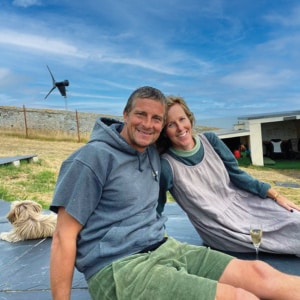
Bear and his wife Shara.
Where my family and I live, the seas around our island home can get really turbulent. One has to be ever respectful of the tidal waters encountered there. I recall some pretty wild crossings, some even made at night, with dogs, supplies and our children all loaded into the boat. With little tolerance for error, I’m not so sure I would be quite that bold now if I was to make those same lively passages again today – a case of getting older and wiser, methinks! But over the 20 years or so we’ve lived here on the island, I’ve learnt to observe and to take more time with things. It’s amazing what you learn just watching the neap and spring tides as they flow to and fro, interacting with the wind and weather. It taught me respect for the sea and an understanding of its forces.
But when it comes to short distances in big seas, such as those under 5 miles or so, I’ve come to the belief that small RIBs can, ironically, be safer than their bigger cousins. Everyone aspires to go bigger, but the truth is, the bigger the boat, the harder it can be to control in big seas and winds. I find RIBs between 5 and 8 metres in length possess a ‘sweet spot’ in terms of waterline and wavelength compatibility. Small, seaworthy deep-vee hulled RIBs can be incredibly agile in big, confused seas. It’s their power-to-weight responsiveness that can prove to be the lifesaver. Obviously, over long passages, you might appreciate having a larger vessel beneath you, if for no other reason than the increased comfort a longer hull can give its crew. But if I was in a force 10 gale and needed to get ashore from our island home, which is about 2 miles in all, I’d be tempted to take our old RNLI D-Class inflatable or even a jet ski! Why are you smiling? It’s true! Keeping it small has much to be said for it. Also, from the standpoint of our boys, they’ve learnt so many skills from playing about and helping with the D-Class and other boats we’ve run over the years.
I will add, though, that our 7.7m Sealegs is the everyday RIB we use for most of our back and forward trips to the island. She’s a tough ‘workhorse’ – a vessel we custom-designed with the NZ manufacturing team. The hull is aluminium as opposed to GRP and has a raised freeboard that makes it very stable and dry. The boat also has foam tubes, which obviously don’t deflate or puncture. If the Sealegs gets whacked on the rocks or quayside in rough weather, as it often does, there’s zero gelcoat to damage and it’s this robustness I absolutely love.
I concur regarding your comments about smaller craft. The most rewarding voyages I’ve made were all aboard smaller craft: Round Britain, Round Ireland, Round Scotland, etc. – I did all these aboard 4.8m RIBs. But wrapping things up, what might your final advice be regarding crisis management?
Well, when it comes to the unexpected or perhaps a crisis at sea, in the heat of the moment, we can sometimes forget to do the obvious. Therefore, I would say that before you go pulling cowlings off outboards and climbing into engine bays, consider dropping an anchor first. Stabilise the boat and give yourself time to think. Always begin your troubleshooting by starting with the obvious first before searching for the more complex.
If you are able to, of course, deploying the anchor will allow you to hold your position. This means that if you need to call for assistance, you can then do this without the complications of having to give updated chart position information. (Ed’s note: You should carry at least 50 metres of warp, shackled to a good few metres of chain. Remember, it’s the chain that provides the vital link in the sequence. Ensure too that your anchor is fully adequate in terms of both size and design for the type of vessel it’s paired to.)
Above all, though, I say to all your readers: have fun! There’s nothing better than being afloat with friends and family. I’ve taught my kids so much about the sea, the elements and nature thanks to our family’s association with boating. More than anything, though, when it comes to the sea, I hope my wife Shara and I have taught our boys to respect the power of the ocean. With respect comes love … What greater lesson could there be to pass on to our children?

Bear Grylls fact file
Bear Grylls is arguably the most recognisable face of adventure on the planet. He is a former British Special Forces soldier, who went on to become one of the youngest ever climbers of Mount Everest, despite breaking his back in a freefall accident only months earlier. After Everest, he undertook several notable maritime voyages that involved demanding ocean crossings aboard custom-made craft of RIB design. Off the back of his adventuring and survival experience, Bear went on to host more extreme adventure-orientated TV shows across more global networks than anyone else in history. His shows include the legendary Discovery Channel show Man vs Wild and the hit show Running Wild with Bear Grylls, now in its eighth season on the National Geographic channel. His Running Wild guests have included President Obama, Roger Federer, Julia Roberts, Prime Minister Narendra Modi of India and many other well-known public figures. Bear also hosts the double Emmy Award-winning interactive Netflix series You vs Wild. He is a family man, as well as a top bestselling author, having now sold in excess of 20 million books. He is the Honorary Colonel to the British Royal Marine Commandos and the first ever Chief Ambassador to 55 million young Scouts worldwide.

